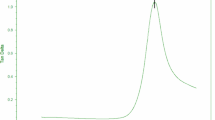Abstract
In comparison to conventional hot embossing with a precisely aligned pair of hard mold plates, the rubber-assisted hot embossing process with a modified embossing tool that employs only one hard mold plate containing through-thickness open microchannels was investigated both experimentally and numerically. The numerical process dynamics model was constructed using a hyperelastic constitutive model to describe the large deformation behavior of the embossing film at an embossing temperature near the glass transition temperature. Both experimental and numerical results showed that excellent replication of microchannel patterns can be achieved using the simplified tool setup and an embossing temperature slightly above Tg is suitable for achieving a uniform embossing thickness. Additional advantages from the use of open channels on the embossing mold include reduced diesel effect in the mold cavity and improved surface smoothness of the embossed film. The simulation results agreed very well with the experimental observations for the effects of the main process parameters on the replication quality, and this study demonstrated that the hyperelastic process model is capable of predicting the basic characteristics of the rubber-assisted embossing process with an open-channel embossing mold.










Similar content being viewed by others
References
Beda T (2007) Modeling hyperelastic behavior of rubber: a novel invariant-based and a review of constitutive models. J Polym Sci Part B Polym Phys 45:1713–1732
Guo Y, Liu G, Zhu X, Tian Y (2007) Analysis of the demolding forces during hot embossing. Microsyst Technol 13:411–415
Lan S et al (2009) A parameter study on the micro hot-embossing process of glassy polymer for pattern replication. Microelectron Eng 86:2369–2374
Nagarajan P, Yao D (2006) Rubber-assisted hot embossing for structuring thin film polymeric films. 2006 ASME International Mechanical Engineering Congress and Exposition, Chicago
Nagarajan P, Yao D (2009) Rubber-assisted micro forming of polymer thin films. Microsyst Technol 15:251–257
Nagarajan P, Yao D (2011a) Uniform shell patterning using rubber-assisted hot embossing process. I. Experimental. Polym Eng Sci 51:592–600
Nagarajan P, Yao D (2011b) Uniform shell patterning using rubber-assisted hot embossing process. II. Process analysis. Polym Eng Sci 51:601–608
Park JM, Kang TG, Park SJ (2011) Numerical simulation of hot embossing filling stage using a viscoelastic constitutive model. Korea Aust Rheol J 23:139–146
Song X, Shan XC, Chow SL, Deng XY, Teo WS (2015) Numerical and experimental study of the filling stage of roll-to-roll UV embossing process with micro features. Microsyst Technol 21:1729–1738
Srivastava V, Chester SA, Ames NM, Anand L (2010) A thermo-mechanically-coupled large-deformation theory for amorphous polymers in a temperature range which spans their glass transition. Int J Plast 26:1138–1182
Taylor H, Lam YC, Boning D (2009) A computationally simple method for simulating the micro-embossing of thermoplastic layers. J Micromech Microeng 19:75007
Worgull M, Heckele M (2004) New aspects of simulation in hot embossing. Microsyst Technol 10:432–437
Zhao D, Wyatt T, Wang M, Yi A, Yao D (2012) Rubber-assisted embossing of polymer thin films using molds with through-thickness microchannels. Microsyst Technol 18:481–488
Acknowledgments
This work was supported by the National Natural Science Foundation of China (NSFC) under Grant Number 51275071 and the National Key Basic Research Development Program of China (973 Program) under Grant Number 2012CB025905.
Author information
Authors and Affiliations
Corresponding authors
Rights and permissions
About this article
Cite this article
Zhao, D., Wang, H., Wang, L. et al. Experimental and numerical study of microchannel formation in rubber-assisted hot embossing with an open-channel mold. Microsyst Technol 23, 1221–1227 (2017). https://doi.org/10.1007/s00542-016-2898-z
Received:
Accepted:
Published:
Issue Date:
DOI: https://doi.org/10.1007/s00542-016-2898-z



